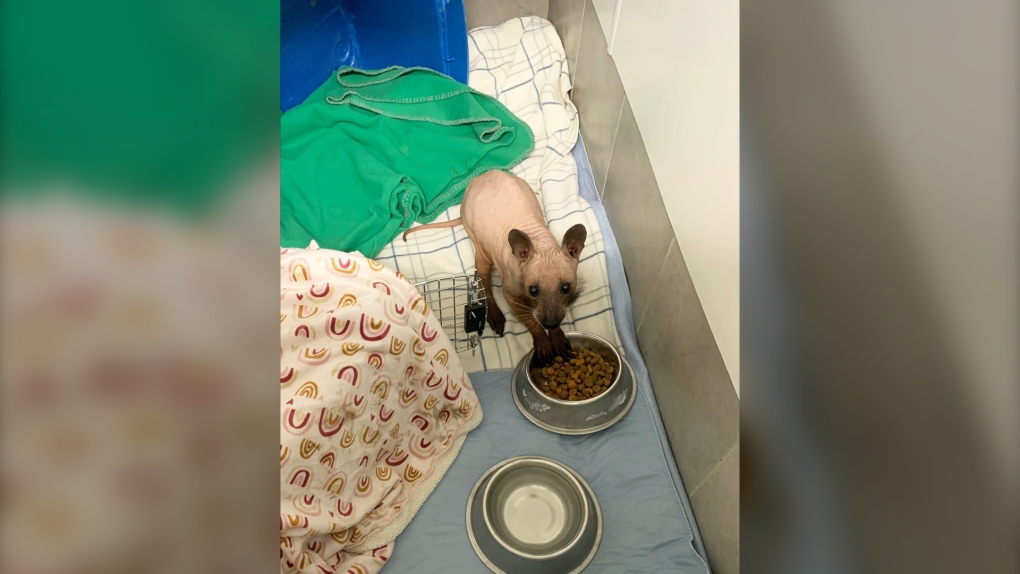Nova Scotia's Hope For Wildlife welcomes 'completely bald' raccoon
Hope For Wildlife, a wildlife rehabilitation centre in Seaforth, N.S., has recently taken an animal into its care and its appearance may have some people doing a double take.
The centre posted photos of a northern raccoon with what is believed to be alopecia – otherwise known as hair loss – on its Facebook page Wednesday morning.
The animal is described as “completely bald" in addition to being “not friendly” and “feisty.”
The post says the animal is a female, though Hope Swinimer, the founder and director of Hope for Wildlife, later referred to it as a male.
She says the centre received a call from people in Cape Breton who discovered the animal, but they weren’t sure what it was at first.
“Once we got a live trap and were able to bring him in, it was clear that he was a raccoon, but he’s a bald raccoon," Swinimer says.
Swinimer says she has only see two bald raccoons in the 25 years she has been doing wildlife work.
“We don’t see it very often, but in every species we do get cases in where the animals come in bald, but it might happen once a year,” she says.
 A bald raccoon is pictured at Hope For Wildlife, a wildlife rehabilitation centre in Seaforth, N.S. (Source: Facebook/Hope For Wildlife)
A bald raccoon is pictured at Hope For Wildlife, a wildlife rehabilitation centre in Seaforth, N.S. (Source: Facebook/Hope For Wildlife)
Hope For Wildlife says the critter could have an autoimmune disorder, though it hasn’t been fully diagnosed yet.
“We’re going to sedate him over the next couple of days, there’s no big hurry because he’s healthy, and just do some skin scraping, maybe a biopsy just to be sure it’s something genetic, like alopecia, something like that,” says Swinimer.
The wildlife rehabilitation centre says it is “amazed” the animal was able to live through the winter without any injuries -- or fur.
“How this little guy lived through the whole winter without any fur, I don’t know," Swinimer says. "He would of succumbed to the temperatures if he wasn’t probably sleeping away a lot of the winter and not coming out very often, but he looks really healthy.”
But can the animal go back to the wild without fur? Swinimer says it’s hard to say.
“I think the long-term prognosis is good,” she says. “However, he may not be able to have a typical life in the wild.”
 A raccoon with alopecia has a bite to eat at a wildlife rehabilitation centre in Seaforth, N.S. (Source: Facebook/Hope For Wildlife)
A raccoon with alopecia has a bite to eat at a wildlife rehabilitation centre in Seaforth, N.S. (Source: Facebook/Hope For Wildlife)
For now, the raccoon has been given the name "Rufus" by one of Hope For Wildlife's staff members after the naked mole-rat character on Kim Possible, a Disney TV series.
Hope For Wildlife is no stranger to interesting raccoons – they’ve previously welcomed several albino ones.
For more Nova Scotia news visit our dedicated provincial page.
CTVNews.ca Top Stories

Richard Perry, record producer behind 'You're So Vain' and other hits, dies at 82
Richard Perry, a hitmaking record producer with a flair for both standards and contemporary sounds whose many successes included Carly Simon’s 'You’re So Vain,' Rod Stewart’s 'The Great American Songbook' series and a Ringo Starr album featuring all four Beatles, died Tuesday. He was 82.
Hong Kong police issue arrest warrants and bounties for six activists including two Canadians
Hong Kong police on Tuesday announced a fresh round of arrest warrants for six activists based overseas, with bounties set at $1 million Hong Kong dollars for information leading to their arrests.
Read Trudeau's Christmas message
Prime Minister Justin Trudeau issued his Christmas message on Tuesday. Here is his message in full.
Stunning photos show lava erupting from Hawaii's Kilauea volcano
One of the world's most active volcanoes spewed lava into the air for a second straight day on Tuesday.
Indigenous family faced discrimination in North Bay, Ont., when they were kicked off transit bus
Ontario's Human Rights Tribunal has awarded members of an Indigenous family in North Bay $15,000 each after it ruled they were victims of discrimination.
What is flagpoling? A new ban on the practice is starting to take effect
Immigration measures announced as part of Canada's border response to president-elect Donald Trump's 25 per cent tariff threat are starting to be implemented, beginning with a ban on what's known as 'flagpoling.'
Dismiss Trump taunts, expert says after 'churlish' social media posts about Canada
U.S. president-elect Donald Trump and those in his corner continue to send out strong messages about Canada.
Heavy travel day starts with brief grounding of all American Airlines flights
American Airlines briefly grounded flights nationwide Tuesday because of a technical problem just as the Christmas travel season kicked into overdrive and winter weather threatened more potential problems for those planning to fly or drive.
King Charles III is set to focus on healthcare workers in his traditional Christmas message
King Charles III is expected to use his annual Christmas message to highlight health workers, at the end of a year in which both he and the Princess of Wales were diagnosed with cancer.

































